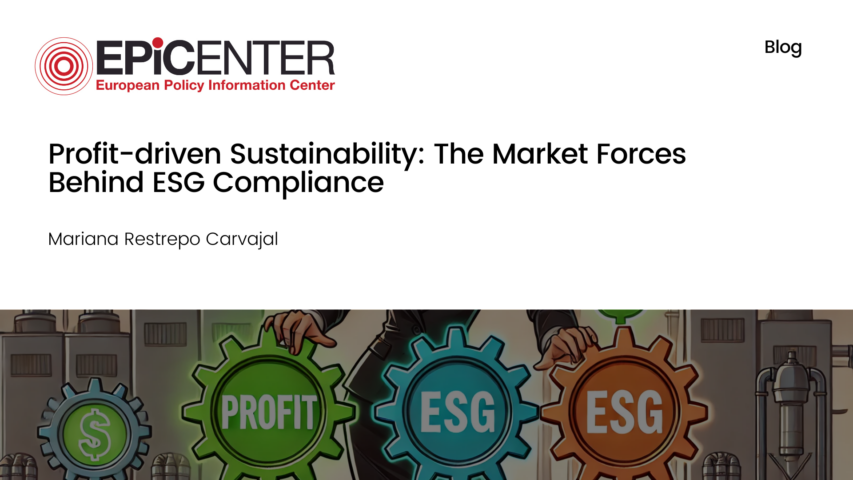Profit-driven Sustainability: The Market Forces Behind ESG Compliance

Profit-driven Sustainability: the Market Forces Behind Esg Compliance
Mariana Restrepo Carvajal // 23 August 2023
Politicians often forget that it is profit that drives firms in a society built upon the tangible benefits of capitalism, and that it is the pursuit of profit that will lead companies to adopt sustainable environmental, social, and governmental (ESG) practices. Hence, due to this misunderstanding of market dynamics, in recent years, as the race against climate change intensifies, governments have imposed mandatory ESG regulations and reporting obligations for companies. Unfortunately, these end up harming financial performance, stifling innovation, and negatively impacting consumers.
More than 200 years ago, Adam Smith wrote, ‘There is one and only one social responsibility of business – to use its resources and engage in activities designed to increase its profits’, and this timeless statement holds more relevance now than ever. The economist highlighted the idea that the collective pursuit of individual interests would ultimately lead to the optimisation of society’s well-being. Markets function not because of the goodwill of enterprises or citizens but rather of the pursuit of their self-interest, which, in simplistic terms, leads to a reduction in production costs and the development of new and better products that satisfy society’s needs.
Seeing profit-driven firms as evil organisations and implementing mandatory ESG reporting derives from a misunderstanding of the functioning of our market economy and can have devastating consequences. In a free-market economy, companies face two different forces that guide their decisions: costs and consumer preferences; in today’s world, both push businesses towards voluntary ESG compliance.
First off, consumers are increasingly concerned about environmental and social issues and take this into account in their daily decisions. It’s not just talk either; a study conducted by the European Investment Bank showed that 45 per cent of Europeans consider climate change when they choose their bank, 67 per cent say that they consider it when choosing their holiday plans, and 67 per cent say that they would only buy a hybrid/electric vehicle.
More importantly, companies are noticing this shift in consumer behaviour. A recent study conducted by McKinsey showed that products that claim to be ESG-responsible have seen an average of 28 per cent cumulative growth in their sales over the past five years in comparison to just 20 per cent for products that do not. Hence, in a competitive market, companies will be pressured by consumer preferences to become more environmentally and socially sustainable in order to maximise their profits.
Then, we have the other primary market force: costs. One of the industries that concerns ESG activists the most is energy, due to its negative impact on climate change. For the past decades, governments all over the world have intervened in the market to incentivise the use of renewable energies, but despite efforts, in February 2021, the UN submitted a report stating that the world was not on track to meet the Paris Agreement energy goals.
However, 2022 brought good news for environmentalists when the landscape began to shift and renewable and nuclear power reached record utilisation levels. According to a recent report by research firm Ember, in 2022, renewables and nuclear power were responsible for a jaw-dropping 39 per cent of global electricity generation and new solar-energy developments in Europe were 50 per cent higher than in 2021 (Bove 2023). Surprisingly, a big percentage of these investments came from some of the world’s top oil producers such as TotalEnergies or BP, who faced market pressure due to higher oil costs and changing consumer preferences.
As costs of producing renewable energy decrease due to the development of new technologies, and external shocks such as the COVID-19 pandemic and resource scarcity drive up oil and coal prices, renewable alternatives are naturally becoming the preferred source of energy. Therefore, voluntary ESG commitment in this industry is on the rise, and it is not going to stop anytime soon. While energy remains the most obvious example, the ESG trap has extended its influence across most industries.
Patagonia and Ørsted are two of the many examples of market forces incentivising companies to become more sustainable. In the early 2000s, Ørsted’s primary business was fossil fuel–based energy. However, as the world’s concerns over climate change grew louder and technological advancements made wind energy more affordable, the fossil fuel–based company made a bold decision that drastically changed its business. Now, Ørsted stands tall as a sustainable energy producer and a global leader in wind energy.
Patagonia’s story is no less inspiring. This company witnessed a change in consumer preferences and has effectively tapped into the growing demand for sustainable products by utilising eco-friendly materials, promoting fair labour practices, and even allocating a portion of its sales to support environmental causes. Sales have skyrocketed, but what’s even more surprising is that consumers are willing to pay a premium for products that align with their values. These two remarkable success stories are prime examples of how market forces can work wonders in encouraging companies to comply with ESG practices without the need for government intervention.
In the pursuit of fostering social responsibility, imposing mandatory ESG compliance and reporting may ironically prove to be one of the most socially irresponsible practices. Rather than burdening businesses, governments have the social responsibility to improve investment incentives for profit-led firms and trust market forces to drive said businesses towards ESG sustainability. By understanding that it is not businesses’ social responsibility to comply with ESGs, we can pave the way for a truly sustainable future without sacrificing economic stability, growth, or innovation.
Download or share this blog post
EPICENTER publications and contributions from our member think tanks are designed to promote the discussion of economic issues and the role of markets in solving economic and social problems. As with all EPICENTER publications, the views expressed here are those of the author and not EPICENTER or its member think tanks (which have no corporate view).



